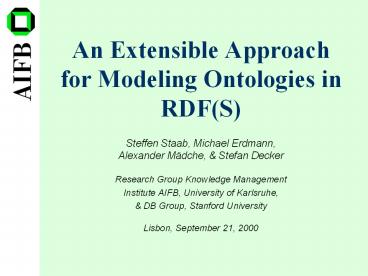An Extensible Approach for Modeling Ontologies in RDF(S)
Title:
An Extensible Approach for Modeling Ontologies in RDF(S)
Description:
Ideal Modeling (WYMIWYG) Modeling not constrained by any language ... For Semantic Web and DAML more than light-weight is needed! Axioms ... –
Number of Views:32
Avg rating:3.0/5.0
Title: An Extensible Approach for Modeling Ontologies in RDF(S)
1
An Extensible Approach for Modeling Ontologies in
RDF(S)
- Steffen Staab, Michael Erdmann, Alexander
Mädche, Stefan DeckerResearch Group Knowledge
Management - Institute AIFB, University of Karlsruhe,
- DB Group, Stanford UniversityLisbon,
September 21, 2000
2
What is an Ontology?
- Light-weight Ontology
- concepts, atomic types
- is-a hierarchy among concepts
- associations between concepts
- Heavy-weight Ontology
- cardinality constraints
- taxonomy of relations
- reified statements
- Axioms / semantic entailments of various tastes
- expressiveness (DL, propositional, horn, or first
order logic, higher order) - inferences
3
Tools for Ontologies
- Light-weight
- uncontroversial
- all Tools support light-weight
- Protege, Stanford
- OntoEdit, Karlsruhe
- UML-Tools, several
- Heavy-weight
- no consensus yet
- layering seems appropriate/necessary
4
Concepts, Relations, ....
5
Modeling
- Ideal Modeling (WYMIWYG)
- Modeling not constrained by any language
- All appropriate epistemological primitives and
modeling styles should be usable - Real Modeling
- A particular language always restricts allowed
primitives (modeling language) - A particular language is needed in
applications(application language) - gt distinguish modeling language from final
application language
translate automatically
6
Axioms
- For Semantic Web and DAML more than light-weight
is needed! - Axioms
- Framework for conceptual modeling of axioms
- Ontology of axiom patterns
- language specific axiom-schemata can work with
that knowledge - Interoperability is an issue
- RDF / RDFS seem appropriate
next slide
next but one slide
7
Axiom Patterns
- 1. Axioms for a relational algebra
- (a) Reflexivity of relations
- (b) Symmetry of relations
- (c) Asymmetry of relations
- (d) Transitivity of relations
- (e) Inverse relations
- (f) Irreflexivity of relations
- (g) Antisymmetry of relations
- 2. Composition of relations
- 3. (Exhaustive) Partitions of Concepts
8
Axiom Patterns
- 4. Axioms for subrelation relationships
- 5. Axioms for part-whole reasoning Winston 87
Chaffin 92 - PhysicalPartOf
- MemberOf
- PortionOf
- PhaseOf
- FeatureOf
- SubRegionOf
- 6. Nonmonotonicity
- 7. Axioms for temporal and modal contexts
- 8. (General axioms (application specific, ad hoc))
9
(No Transcript)
10
Example of Composition of Relations
ltoComposition rdfID"FatherInLawComp"gt
ltocomposee rdfResource"fatherInLawOf"/gt
ltofirstComponent rdfResource"fatherOf"/gt
ltosecondComponent rdfResource"marriedWith"/gt lt/
oCompositiongt
rdfsProperty
rdfClass
oComposition
oRelation
Composition(fatherInLawOf, fatherOf, marriedWith).
oIrreflexiveRel
forall R,Q,S,X,Y,Z XR -gtgt Z lt- Composition(R,
Q, S) and XQ -gtgt Y and YS -gtgt Z.
osecondComponent
ocomposee
applmarriedWith
ofirstComponent
forall X,Y,Z XfatherInLawOf -gtgt Z
lt- XfatherOf -gtgt Y and YmarriedWith -gtgt Z.
applfatherOf
applfatherInLawOf
11
OntoEdit supports Axiom Classification
fatherInLawOf
fatherOf
marriedWith
12
Ontology Engineering using OntoEdit
- Interaction with the user on a conceptual level
- Multiple views for concepts, relations and axioms
- Multilinguality
- Linkable to NLP domain lexicon
- Exports ontology (incl. axioms) into several
formats - F-Logic (main language)
- RDF/RDFS
- DTDs (as far as possible)
- ORDB-Schema (as far as possible)
- OIL (partially and in RDF)
- UML/XMI (planned)
- the DAML language (when specified -)
13
Ontoedit
14
Frame-Logic Inference Engine Access
Automatically Derived from Axiom views
Pure F-Logic
Debugging Instances Rule Debugging
15
FaCT DL Engine Interface
- Generate FaCT LISP KB (future OIL)
- Call FaCT Client, transform ontology on FaCT
server - Ask server
16
Flexible Epistemological Level
XRDF
OIL
DAML
17
Conclusion
- No Method fits all
- Different applications need
- different representation languages
- with their underlying reasoning services
- Ontology development must be aware of this
- conceptual modeling
- mechanisms to access/integrate several ontologies
- distributed on the web
- identified by (XML-) namespaces
18
Thank You!































